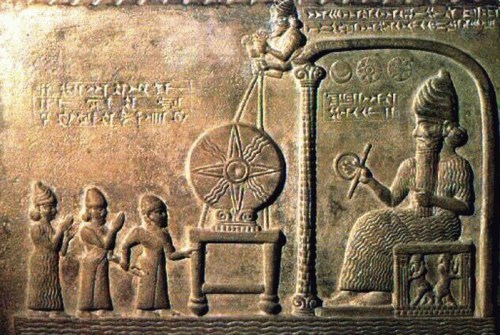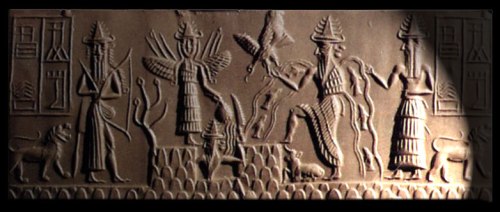Shamash, Sun God, God of Justice
“The cult of Shamash in Assyria dates from at least 1340 B.C., when Pudilu built a temple to this god in the city of Asshur.
He entitled Shamash ‘The Protecting Deity,’ which name is to be understood as that of the god of justice, whose fiat is unchangeable, and in this manner Shamash differed somewhat from the Babylonian idea concerning him.
In the southern kingdom he was certainly regarded as a just god, but not as the god of justice—a very different thing.

Bas relief of the Tablet of Shamash, portraying the god Shamash on his throne, IXth century BCE. British Museum.
It is interesting as well as edifying to watch the process of evolution of a god of justice. Thus in Ancient Mexico Tezcatlipoca evolved from a tribal deity into a god who was beginning to bear all the marks and signs of a god of justice when the conquering Spaniards put an end to his career.
We observe, too, that although the Greeks had a special deity whose department was justice, other divinities, such as Pallas Athene, displayed signs that they in time might possibly become wielders of the balances between man and man.
In the Egyptian heavenly hierarchy Maat and Thoth both partook of the attributes of a god of justice, but perhaps Maat was the more directly symbolical of the two.
Now in the case of Shamash no favours can be obtained from him by prayer or sacrifice unless those who supplicate him, monarchs though they be, can lay claim to righteousness. Even Tiglath-pileser I, mighty conqueror as he was, recognized Shamash as his judge, and, naturally, as the judge of his enemies, whom he destroys, not because they are fighting against Tiglath, but because of their wickedness.

From left, Storm God Ninurta, with bows and arrows. Ishtar, queen of heaven and earth, is elevated, with wings and spears and maces on her shoulders. The tree of life sprouts to her right, our left.
The Sun God Shamash rises from the mountain Kur in the center, with rays of light on his shoulder. The God of Water and Wisdom, Enki/Ea battles the bird-god Imdugud/Anzu, with depictions of the Tigris and Euphrates rivers and fish coursing from his shoulders.
At far right is the deified vizier Usmu, the two-faced.
All gods wear conical hats with four pairs of horns. At far left is the word Adda in Accadian cuneiform, “Scribe.” Accordingly this cylinder seal is known as the Seal of Adda, Akkadian period, 2350-2100 BCE. British Library.
http://www.ancientworlds.net/aw/Article/787375
When he set captives free Tiglath took care to perform the gracious act before the face of Shamash, that the god might behold that justice dwelt in the breast of his royal servant. Tiglath, in fact, is the viceroy of Shamash upon earth, and it would seem as if he referred many cases regarding whose procedure he was in doubt to the god before he finally pronounced upon them.
Both Assur-nazir-pal and Shalmaneser II exalted the sun-cult of Shamash, and it has been suggested that the popularity of the worship of Ra in Egypt had reflected upon that of Shamash in Assyria.
It must always be extremely difficult to trace such resemblances at an epoch so distant as that of the ninth century B.C. But certainly it looks as if the Ra cult had in some manner influenced that of the old Babylonian sun-god.
Sargon pushed the worship of Shamash far to the northern boundaries of Assyria, for he built a sanctuary to the deity beyond the limits of the Assyrian Empire—where, precisely, we do not know.
Amongst a nation of warriors a god such as Shamash must have been valued highly, for without his sanction they would hardly be justified in commencing hostilities against any other race.”
Lewis Spence, Myths and Legends of Babylonia and Assyria, 1917, pp. 222-3.
